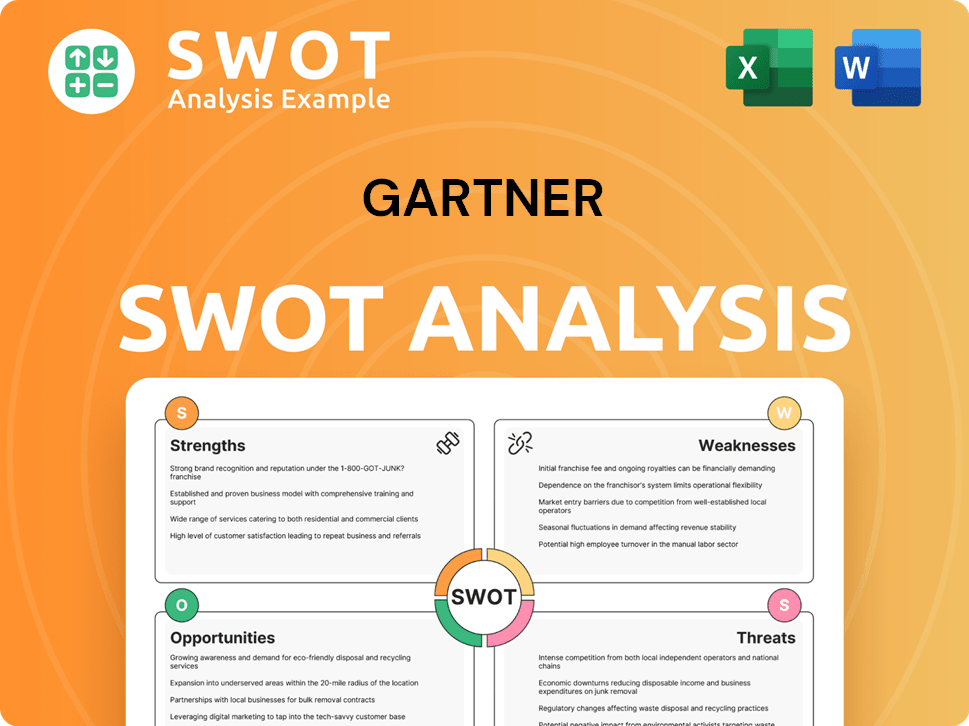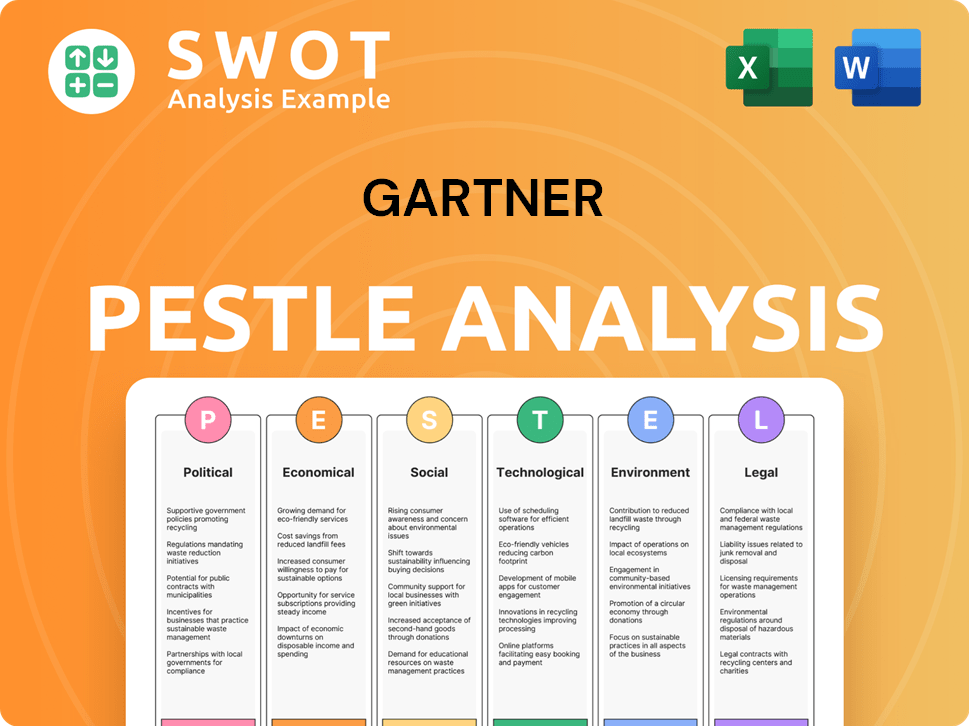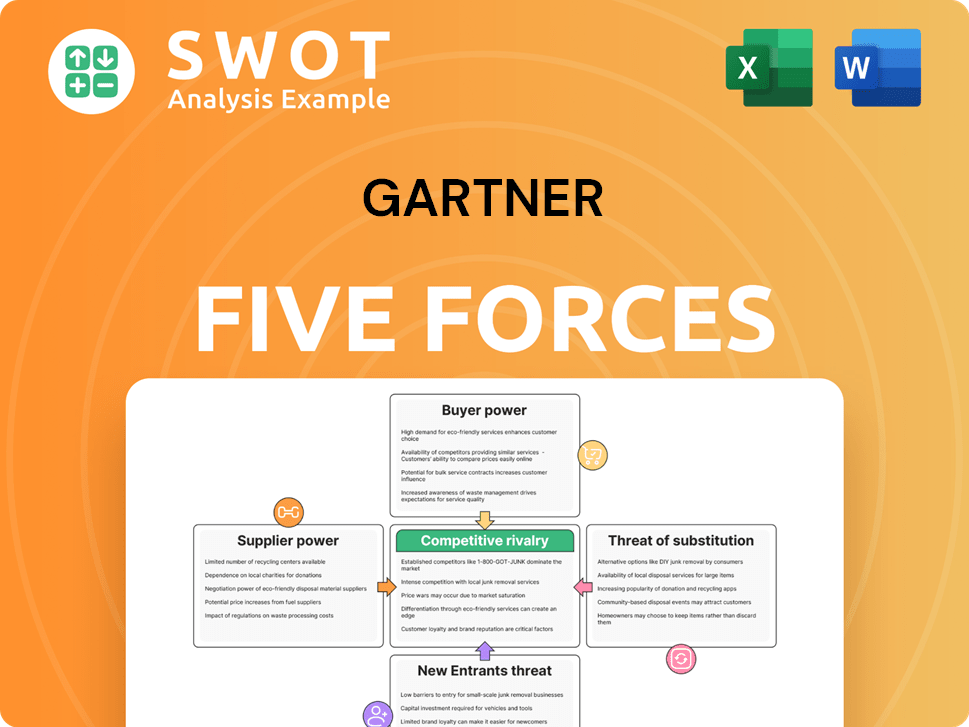Gartner Bundle
How Did Gartner Become a Global Powerhouse?
In today's fast-paced business world, understanding the evolution of influential companies is crucial. Gartner, a leading research and advisory firm, has a fascinating history. Founded in 1979 by Gideon Gartner, the company's journey from an IT research startup to a global leader is a testament to its strategic vision. This brief history will explore the key milestones that shaped Gartner's success.

From its inception as Gartner Group, Inc., focusing on Gartner SWOT Analysis and IT research, the company quickly adapted to the changing technological landscape. Gartner's early years saw it establish a strong foothold in the IT industry, providing critical insights during the rise of personal computing. Its evolution reflects a commitment to providing actionable intelligence and market analysis, solidifying its position as a trusted advisor for businesses worldwide. Understanding the Gartner company timeline helps to understand its impact.
What is the Gartner Founding Story?
The story of the Gartner company begins in 1979. It was founded by Gideon Gartner and David Stein, who saw a gap in the market for expert technology advice.
Gartner's early focus was on providing specialized information to businesses navigating the rapidly evolving computer industry. This brief history of Gartner highlights how it grew from a niche provider to a global leader in IT research.
Gartner, Inc. started with a clear mission: to offer expert guidance on technology products and pricing. Gideon Gartner, with his background at IBM, recognized the need for such insights. David Stein, from Harris Corp., joined him to launch the venture.
Gartner Group, Inc. was initially funded with $675,000 in venture capital. The company's original business model centered on subscription-based IT research, delivered in the form of concise research notes.
- Gideon Gartner, an IBM executive and Wall Street analyst, identified the need for expert IT advice.
- David Stein, an executive at Harris Corp., partnered with Gartner to launch the company.
- The first office was remarkably located within its first client's premises, a New York brokerage house.
- Gartner's research was known for its provocative approach, aiming to address controversial topics.
The initial product offerings were brief, two-page research notes. The company's early operations were quite modest, even operating out of an office rented from its first client. Gideon Gartner believed in a bold approach to research, famously stating that if a topic wasn't controversial, it wasn't worth writing about. The company's name was later simplified to Gartner in 2000.
For those interested in the financial aspects and ownership of the company, more details can be found in this article: Owners & Shareholders of Gartner.
Gartner SWOT Analysis
- Complete SWOT Breakdown
- Fully Customizable
- Editable in Excel & Word
- Professional Formatting
- Investor-Ready Format

What Drove the Early Growth of Gartner?
The early years of the Gartner company saw rapid expansion and the establishment of its core methodologies. The firm quickly gained recognition for its insights, particularly regarding IBM and its products. This period was marked by strategic innovations and significant growth, laying the groundwork for its future success in the IT research industry.
Gartner Group, as it was initially known, began by offering expert perspectives on IBM and its products. This focus helped establish the company's credibility and expertise in the IT sector. This early specialization was crucial in attracting clients and building a strong foundation for future expansion.
By 1983, Gartner Group had grown its team to 80 research analysts. The company generated $8 million in revenue that year, showcasing its early success. This rapid growth demonstrated the market's demand for its IT research and advisory services.
A key innovation was the development of the 'Magic Quadrant' in the early 1980s. This visual framework became a core methodology, helping businesses make informed technology decisions. The Gartner Magic Quadrant history is a significant part of the company's influence.
Gartner's strategic moves included separating its brokerage division, which later became SoundView Financial Group. Throughout the 1990s, Gartner expanded through acquisitions, diversifying into telecommunications, healthcare, and finance. These acquisitions helped broaden the scope of Gartner Inc's offerings.
The Gartner company underwent significant changes, including leadership transitions and name changes. Gideon Gartner's departure and the subsequent launch of Giga Information Group, which later was sold to Forrester, marked a pivotal moment. By 2000, the company simplified its name to Gartner, Inc., reflecting its evolution. For more insights into the Gartner's target audience, check out this article: Target Market of Gartner.
Gartner PESTLE Analysis
- Covers All 6 PESTLE Categories
- No Research Needed – Save Hours of Work
- Built by Experts, Trusted by Consultants
- Instant Download, Ready to Use
- 100% Editable, Fully Customizable

What are the key Milestones in Gartner history?
The Gartner history is marked by significant milestones that have shaped its evolution as a leading IT research and consulting firm. From its early days to its current global presence, the company has consistently adapted and expanded its offerings to meet the evolving needs of the technology industry. The Gartner company has grown significantly, establishing itself as a key player in the industry.
| Year | Milestone |
|---|---|
| 1979 | Founded by Gideon Gartner, the company initially focused on providing IT research and consulting services. |
| Early 1980s | Developed the 'Magic Quadrant', a groundbreaking visual framework for evaluating technology vendors. |
| 1990s | Expanded its services through acquisitions and organic growth, establishing a broader presence in the IT research market. |
| 2000s | Continued to evolve its offerings, including executive programs and consulting services, to meet changing market demands. |
| 2024 | Reported revenues of $6.3 billion, demonstrating continued growth and financial success. |
One of the most significant innovations in Gartner Inc’s history was the development of the 'Magic Quadrant', a widely recognized framework for assessing technology vendors. This tool has become a cornerstone of the company's research, providing strategic guidance to organizations and helping them align their long-term plans with industry trends.
The Magic Quadrant, introduced in the early 1980s, revolutionized how technology vendors were evaluated. It provided a visual and easily understandable framework for comparing vendors based on their vision and ability to execute.
The introduction of the 'Gartner Hype Cycle' helped in understanding the maturity and adoption of emerging technologies. This tool has become a popular resource for businesses to assess technology trends.
Gartner expanded its services beyond traditional research reports. This included executive programs and consulting to meet the evolving needs of its clients and the market.
Strategic acquisitions have been a key part of Gartner's growth strategy. These acquisitions have broadened its market reach and expanded its service offerings.
Gartner's research methodologies have consistently emphasized data-driven insights. This approach has helped the company to provide valuable and reliable information to its clients.
Gartner has expanded its global presence. This has allowed it to serve a diverse client base and provide insights into regional market trends.
Throughout its history, Gartner Group has faced various challenges, including market downturns and competitive threats. The company has demonstrated resilience by adapting its offerings and business model to remain competitive.
In its early history, Gartner faced a lawsuit from IBM. This required the company to navigate legal complexities and demonstrate its commitment to its mission.
Market downturns have presented challenges, requiring Gartner to adapt its strategies. This included adjusting its focus to meet changing client needs.
The competitive landscape in the IT research industry has intensified. Gartner has responded by continuously innovating and expanding its services.
Economic uncertainties have posed challenges to Gartner's business. The company has responded by focusing on delivering value to its clients.
The rapid evolution of the technology landscape has required Gartner to continuously adapt its research methodologies. This helps to stay relevant in the industry.
Gartner has had to consistently evolve its offerings to maintain its relevance. This includes adapting to new technologies and market trends.
Gartner Business Model Canvas
- Complete 9-Block Business Model Canvas
- Effortlessly Communicate Your Business Strategy
- Investor-Ready BMC Format
- 100% Editable and Customizable
- Clear and Structured Layout

What is the Timeline of Key Events for Gartner?
The Gartner history began in 1979 when Gideon Gartner and David Stein established Gartner Group, Inc. in Stamford, Connecticut. Initially, it focused on IT industry research, particularly concerning IBM. The company has since evolved through several key acquisitions and strategic shifts, becoming a leading source of IT research and insights. The Gartner company has significantly influenced the technology landscape.
| Year | Key Event |
|---|---|
| 1979 | Gartner Group, Inc. is founded, focusing on IT industry research and analysis. |
| Early 1980s | Gartner analysts develop the 'Magic Quadrant' visual framework. |
| 1983 | The firm employs 80 research analysts and generates $8 million in revenue. |
| 1985 | Gartner's brokerage and investment division separates to become Gartner Securities. |
| 1993 | Gideon Gartner is pushed out of the CEO role. |
| 2000 | Gartner Group, Inc. changes its name to Gartner Inc. |
| 2004 | Gene Hall becomes CEO and Gartner acquires META Group. |
| 2009 | Gartner acquires AMR Research and Burton Group. |
| 2014 | Gartner acquires Software Advice. |
| 2015 | Gartner acquires CloudHarmony and GetApp. |
| 2019 | Gartner acquires TOPO. |
| 2024 | Gartner reports total revenues of $6.3 billion and a net income of $1.3 billion. |
Gartner anticipates a surge in generative AI spending, predicting a 76.4% increase globally in 2025, reaching $644 billion. The company identifies Agentic AI and AI Governance Platforms as top strategic technology trends. This focus highlights the transformative potential of AI across various business functions.
Gartner forecasts that by 2028, at least 15% of everyday business decisions will be made autonomously using AI agents. This represents a significant shift from near 0% in 2024. The company recommends that acquiring AI companies be a priority in business strategies for 2024.
Gartner projects continued growth in information security spending, with India's spending alone expected to reach $3.3 billion in 2025, a 16.4% increase from 2024. This growth is driven by persistent security challenges, including data sprawl and ransomware attacks, highlighting the ongoing importance of robust security measures.
Gartner's strategic initiatives are heavily influenced by the pervasive impact of Artificial Intelligence (AI) and the evolving digital landscape. The company's 2025 strategic technology trends highlight AI agents, AI governance platforms, and disinformation security as critical areas. This forward-looking approach ties back to its founding vision of assisting clients in making better decisions about IT.
Gartner Porter's Five Forces Analysis
- Covers All 5 Competitive Forces in Detail
- Structured for Consultants, Students, and Founders
- 100% Editable in Microsoft Word & Excel
- Instant Digital Download – Use Immediately
- Compatible with Mac & PC – Fully Unlocked

Related Blogs
- What is Competitive Landscape of Gartner Company?
- What is Growth Strategy and Future Prospects of Gartner Company?
- How Does Gartner Company Work?
- What is Sales and Marketing Strategy of Gartner Company?
- What is Brief History of Gartner Company?
- Who Owns Gartner Company?
- What is Customer Demographics and Target Market of Gartner Company?
Disclaimer
All information, articles, and product details provided on this website are for general informational and educational purposes only. We do not claim any ownership over, nor do we intend to infringe upon, any trademarks, copyrights, logos, brand names, or other intellectual property mentioned or depicted on this site. Such intellectual property remains the property of its respective owners, and any references here are made solely for identification or informational purposes, without implying any affiliation, endorsement, or partnership.
We make no representations or warranties, express or implied, regarding the accuracy, completeness, or suitability of any content or products presented. Nothing on this website should be construed as legal, tax, investment, financial, medical, or other professional advice. In addition, no part of this site—including articles or product references—constitutes a solicitation, recommendation, endorsement, advertisement, or offer to buy or sell any securities, franchises, or other financial instruments, particularly in jurisdictions where such activity would be unlawful.
All content is of a general nature and may not address the specific circumstances of any individual or entity. It is not a substitute for professional advice or services. Any actions you take based on the information provided here are strictly at your own risk. You accept full responsibility for any decisions or outcomes arising from your use of this website and agree to release us from any liability in connection with your use of, or reliance upon, the content or products found herein.